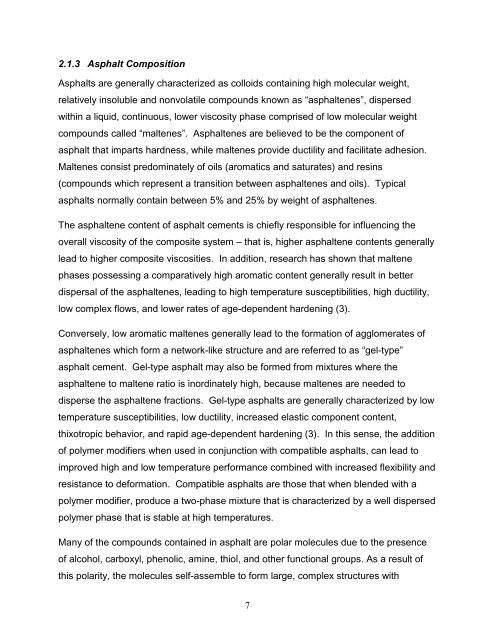Using Polymer Modified Asphalt Emulsions in Surface Treatments A ...
Using Polymer Modified Asphalt Emulsions in Surface Treatments A ...
Using Polymer Modified Asphalt Emulsions in Surface Treatments A ...
You also want an ePaper? Increase the reach of your titles
YUMPU automatically turns print PDFs into web optimized ePapers that Google loves.
2.1.3 <strong>Asphalt</strong> Composition<br />
<strong>Asphalt</strong>s are generally characterized as colloids conta<strong>in</strong><strong>in</strong>g high molecular weight,<br />
relatively <strong>in</strong>soluble and nonvolatile compounds known as “asphaltenes”, dispersed<br />
with<strong>in</strong> a liquid, cont<strong>in</strong>uous, lower viscosity phase comprised of low molecular weight<br />
compounds called “maltenes”. <strong>Asphalt</strong>enes are believed to be the component of<br />
asphalt that imparts hardness, while maltenes provide ductility and facilitate adhesion.<br />
Maltenes consist predom<strong>in</strong>ately of oils (aromatics and saturates) and res<strong>in</strong>s<br />
(compounds which represent a transition between asphaltenes and oils). Typical<br />
asphalts normally conta<strong>in</strong> between 5% and 25% by weight of asphaltenes.<br />
The asphaltene content of asphalt cements is chiefly responsible for <strong>in</strong>fluenc<strong>in</strong>g the<br />
overall viscosity of the composite system – that is, higher asphaltene contents generally<br />
lead to higher composite viscosities. In addition, research has shown that maltene<br />
phases possess<strong>in</strong>g a comparatively high aromatic content generally result <strong>in</strong> better<br />
dispersal of the asphaltenes, lead<strong>in</strong>g to high temperature susceptibilities, high ductility,<br />
low complex flows, and lower rates of age-dependent harden<strong>in</strong>g (3).<br />
Conversely, low aromatic maltenes generally lead to the formation of agglomerates of<br />
asphaltenes which form a network-like structure and are referred to as “gel-type”<br />
asphalt cement. Gel-type asphalt may also be formed from mixtures where the<br />
asphaltene to maltene ratio is <strong>in</strong>ord<strong>in</strong>ately high, because maltenes are needed to<br />
disperse the asphaltene fractions. Gel-type asphalts are generally characterized by low<br />
temperature susceptibilities, low ductility, <strong>in</strong>creased elastic component content,<br />
thixotropic behavior, and rapid age-dependent harden<strong>in</strong>g (3). In this sense, the addition<br />
of polymer modifiers when used <strong>in</strong> conjunction with compatible asphalts, can lead to<br />
improved high and low temperature performance comb<strong>in</strong>ed with <strong>in</strong>creased flexibility and<br />
resistance to deformation. Compatible asphalts are those that when blended with a<br />
polymer modifier, produce a two-phase mixture that is characterized by a well dispersed<br />
polymer phase that is stable at high temperatures.<br />
Many of the compounds conta<strong>in</strong>ed <strong>in</strong> asphalt are polar molecules due to the presence<br />
of alcohol, carboxyl, phenolic, am<strong>in</strong>e, thiol, and other functional groups. As a result of<br />
this polarity, the molecules self-assemble to form large, complex structures with<br />
7
















